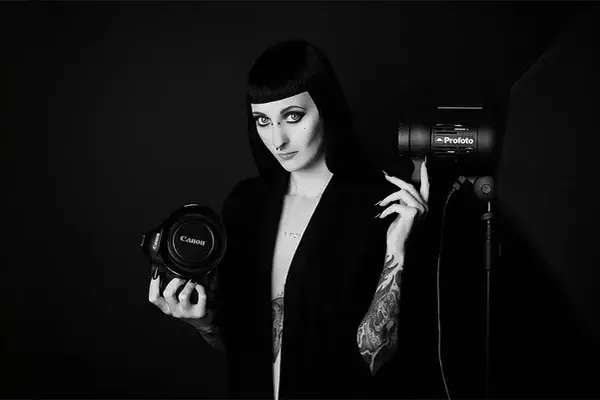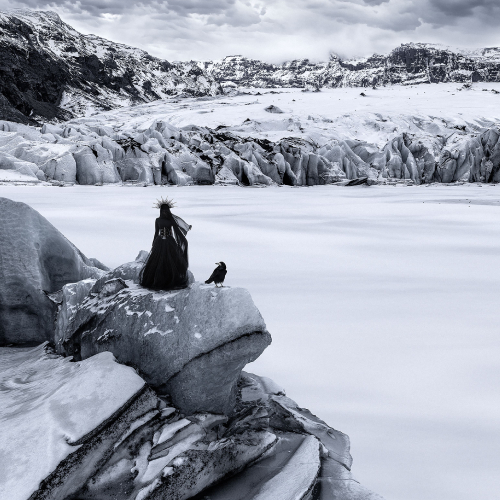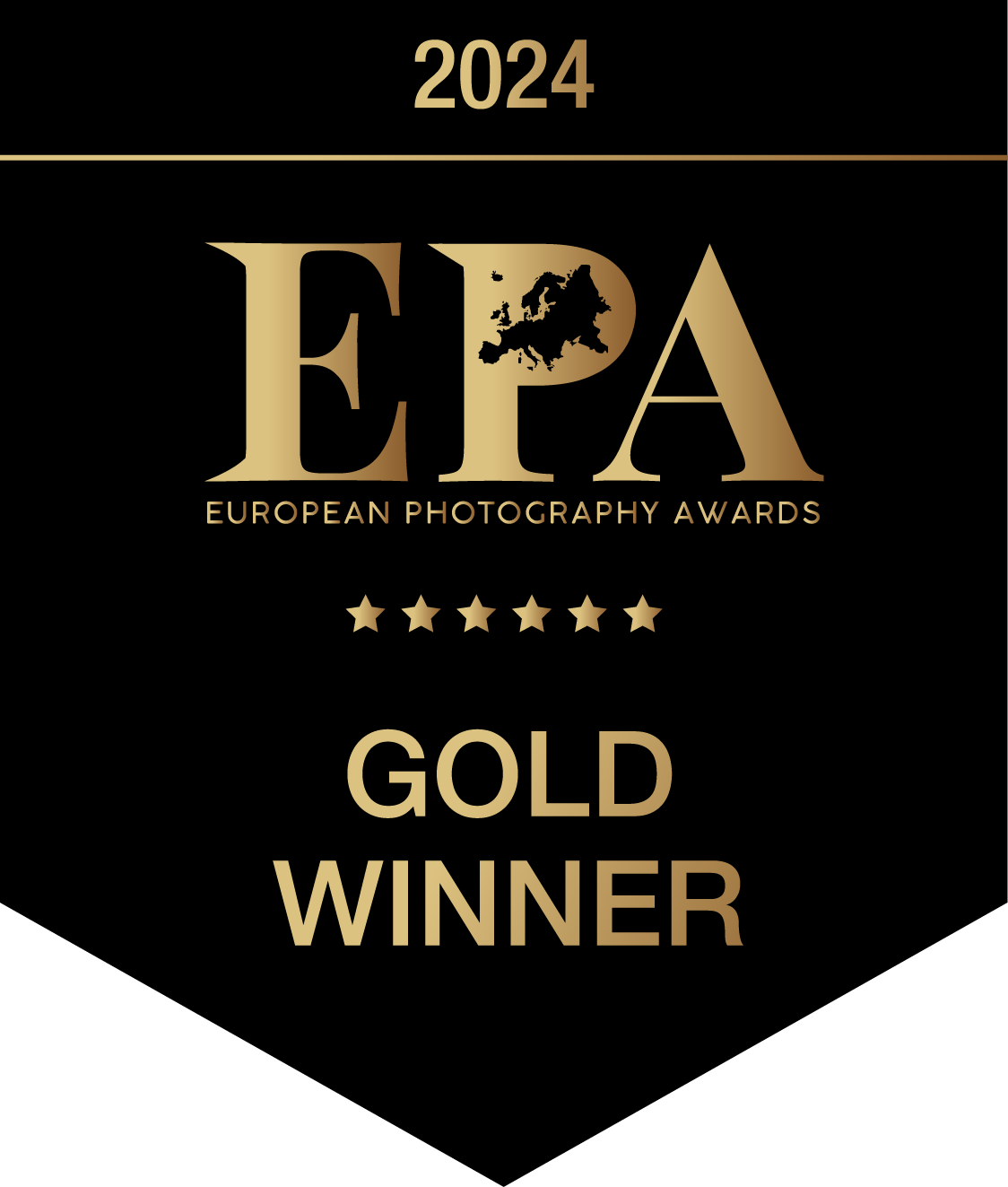
Jaqueline Vanek
1. Can you introduce yourself and talk about how you got into photography?
My name is Jaqueline Vanek (Austria, 1984) and I am a Fine Art Photographer, Portraitist, Visual Artist & Senior Visual UX/UI Designer, currently living in Madrid, Spain. In my personal work, I use the instruments of darkness, surrealism, and photography to talk about my deepest feelings; emotions, states of mind, mind shifts, and more. I started my photographic artist journey back in 2005, after my studies in Fine Arts, Casting and Moulding; and my career in the world of design in the year 2011, specialising in visual web design.
During my whole life, especially as a kid, I have lost count of how many times I have moved, not only from home but also from cities and countries. That is why, forever, photography has played an important role in my memory of these past years. I have always clung to getting photographs that narrated part of my life, even hiding those that I found scattered and half lost in corners of my parents.
2. Where did you study photography?
My photographic artist journey started back in 2005, after my studies in Fine Arts, Casting, and Moulding. I obtained my first studies as a Senior Technician in Fine Arts and Artistic Photography at the "School Of Arts And Design Gran Canaria" in the Canary Islands, Spain. Two years later, in 2007, I moved to Madrid and obtained an MA Degree in Digital Fashion, Portrait, and Advertising Photography at "TAI The University Of Arts And Entertainment". After that, everything has been a lot of practice, experimenting, and taking numerous workshops and online courses.
When I think about my photographic studies, I feel proud to be able to say that I have been among the last ones who have started studying in school classrooms with photographic enlargers and chemicals, then moving to digital. I remember the smell of the developers perfectly, and I still have buckets, red lights, and some other utensils from the dark room.
3. Do you remember your first shot? What was it?
It was when I was about ten years old with my first (very bad and cheap) reflex camera. I always took my camera with one or two rolls of film on school trips and took terrible photos of my classmates and teachers. At that time the only purpose was to generate memories, with no artistic background. The first selfies came a few years later at the end of the nineties, beginning of 2000, when I was between 14 and 16 years old and when compact cameras with more or less affordable prices became fashionable.
4. What equipment do you use?
Since the beginning of 2023, I have been working mainly with a Canon EOS R5; previously, I had been happy with a Canon EOS-1D Mark IV for many years, I still have it, and it works perfectly. My three most used lenses are a Canon Zoom Lens EF 16-35mm, Canon Zoom Lens Ef 24-70mm, and the incredibly wonderful Canon RF 50mm F1.2 L USM. As for studio lighting, my lighting equipment is made up of Profoto material. I also use a Mac Mini with a 43-inch screen, a MacBook Pro, and a Wacom Intuos Pro to retouch.
On the other hand, I also collect older analog cameras, I have quite a few, and they all work. My favorite is a Mamiya RZ67 medium format camera; sometimes, I use it for more creative work. I have a special affection for it because when I was still studying, a small patron from Japan gave it to me without knowing me beyond the Internet. Simply my work at that time caught his attention, and he wanted to contribute something to my creativity and future. I have also built several pinhole cameras, with which I have also done some work, but I haven’t used them for many years.
5. What do you hope to achieve?
As a fine art photographer focusing on self-portraiture, my primary aim would be to explore and express the complexities of identity, self-perception, and the human condition. Self-portraits offer a unique opportunity to delve deeply into personal introspection, allowing me to communicate aspects of my inner world that might otherwise remain hidden.
One key goal would be to use self-portraiture as a medium for self-exploration and discovery. Through the process of photographing myself, I would seek to understand and express different facets of my identity, emotions, and experiences. This could involve confronting vulnerabilities, celebrating strengths, or exploring various personas, ultimately creating a visual narrative that reflects my journey of self-awareness and growth.
Another objective would be to challenge and subvert societal norms and expectations related to identity, beauty, and self-representation. By experimenting with different techniques, styles, and concepts, I would aim to create self-portraits that question conventional ideas of what it means to portray oneself. This might involve playing with abstraction, distortion, or symbolism to convey deeper meanings or to comment on broader cultural issues.
Additionally, I would hope to connect with others on a more universal level through my self-portraits. While the artwork would be deeply personal, the emotions and themes I explore—such as vulnerability, strength, isolation, or connection—are experiences that resonate with many. By sharing my own journey, I would aim to create a space for others to reflect on their own experiences and to foster a sense of empathy and understanding.
Ultimately, my goal would be to use self-portraiture as a means of artistic expression that goes beyond mere self-representation, instead offering a window into the complex and multifaceted nature of the human experience.
A dream would also be to be able to make a living entirely from art, but with one's feet on the ground and being realistic, in the current era that is very difficult to achieve, one always ends up also doing more commercial work and various commissions.
6. What compliment inspired/touched you the most?
The biggest and most meaningful compliments always come from the most significant people in my life, people I care about, admire, or inspire me. On the other hand, it is also a huge compliment to me every time someone buys an artwork of mine, the thought that someone likes my work so much that they want to see it every day hanging on a wall in their house fills me with pride and moves me a lot. Also, winning an award is a very big compliment, because it fuels motivation, and passion and keeps creativity going.
7. What inspires your unique storytelling?
I like to visit at least 2 or 3 exhibitions a week, discover artists in general, and see new works of all possible styles. I can’t imagine not going to see a new exhibition in a whole month. Art is an inspiration in all of its variants, even if we don’t realise it; you can always learn something, and it helps you or inspires you to create in one way or another. I also often spend the day listening to podcasts related to the world of art or at night I watch documentaries. Being an artist is being in an eternal learning and evolution phase.
Since I started with photography, I have gone through an endless number of different styles until I found myself in the one that made me feel most comfortable and where I feel most represented. I have worked in the world of fashion, making beauty portraits and editorials with models, I have gone through landscape and architecture photography, documentary photography, and photography related to the world of music, until finally reaching the conclusion that what I am most passionate about is creating through my feelings with the use of the self-portrait.
My own life, and my experiences, are the ones that have made me evolve as an artist. Our experiences make us who we are and therefore make us create the things we create. Good and bad experiences, trips to places around the world, the people you get to know, the feelings we experience, all of this make us evolve. In my case, many things have marked me as I am a very sensitive person, although I appear to be tough. Like many people, I too, at a specific point in my life, have visited a psychologist for some time for personal problems. When I went to the consultations, the psychologist always asked me to write down my feelings until the next appointment, but writing was not my forte. There arose the use of self-portraits as a means of expression and storytelling.
8. What THREE (3) words describe your photography style?
I consider having a very defined style when I do personal artwork in black and white due to the use of contrast and colour due to my selection of cold tones and low saturation. Very often, I also make use of an element repeatedly, the bird; with the passage of time, it has become a very significant and representative element in my artwork.
But, if I had to say three words they would be: Darkness, sensuality, and emotions.
9. Congratulations! As the winner of the European Photography Awards, what does it mean for you and your team to receive this distinction?
I feel very honoured! In recent years I have had the pleasure of having won several awards and I am excited about each one as if it were the first. It always gives me a boost of confidence and motivation to continue working hard and striving to improve my skills as an artist and photographer. I am also always very grateful and humbled to be recognised along with many talented people around the globe, and to be part of this awesome award competition!
10. Can you explain a bit about the winning work you entered into the 2024 European Photography Awards, and why you chose to enter this project?
The main three topics of "The Mystery of Hrafndís" are the connection with nature and the tranquility of exploration. The search for identity and purpose in a vast and mysterious world. The strength of the bond between a human being and an animal in a landscape of serenity.
These images are part of my new narrative photographic series of self-portraits taken in various locations in Iceland during February 2024. The photographs were taken with a camera on a tripod using a remote shutter and also with a drone. This is the photographic series that so far and in my entire photographic career has been the greatest challenge for me to make, especially due to climate issues. And, it has also been the most expensive to develop, we all know that a trip to Iceland is not cheap.
The series is complemented by a tale I wrote, which I have translated into three languages: English, Spanish, and German. In the future, I will publish a photo book that will contain all the artworks of this series and the tale in its three languages, all in one book. Stay tuned!
Synopsis of the tale is as follows: "In the vast, lonely landscapes of Iceland, an enigmatic figure known as Hrafndís, whose name means "crow goddess", embarks on a solitary and silent journey in search of the secrets hidden among the glaciers. Accompanied only by a raven as her guide and confidant, Hrafndís immerses herself in the icy tranquility in an attempt to merge with the very essence of the land. During her journey, she discovers the dark secrets of nature and her own being."
11. How has winning an award developed your career?
I feel that winning an award has definitely contributed to increasing the sale of my artworks to art collectors, increasing general clientele, level of credibility, and self-empowerment. Being able to show a range of very good and interesting artworks is always what's most important to attract art collectors' or clients' attention, but when the artwork is supported by official international contests, I noticed that many people appreciate the value of my work even more. Unfortunately, we live in a world where many times the more achievements you can show, the better you are supposed to be and the more seriously you are taken. It is something that personally bothers me sometimes.
12. Name 1-3 photographers who have inspired you.
Honestly, I don’t have any specific artists or photographers who inspire me today for my current work. Of course, I have had artists in the past that have motivated me to create in general. When I started studying photography in 2005, my favorite artists were Joel Peter Witkin, Jan Saudek, Shana, Robert Parke Harrison, and Hans Bellmer. I’ve always been attracted to the unusual, the “not too accepted” by general society, the dark, and the surreal.
13. What was the best piece of advice you were given starting out, by a mentor or your role model?
On the one hand, consistency is the key to everything. On the other hand, learn and study others, but don't compare yourself to them or become obsessed. Do what moves you without thinking about "will others like it?". Be yourself, be your original version, not a copy of someone else. As Oscar Wilde's saying goes: "Be yourself; everyone else is already taken".
14. What advice would you give someone who would like to become a photographer today?
I would give the same advice that I have been given about perseverance and being yourself. I would also advise you to learn and make mistakes as you go, it's the best and quickest way to be skilled and experienced at something. Start practicing regularly and learning as much as possible by taking photography courses (in person or online), reading books and articles, and seeking out mentorship or guidance from experienced artists or photographers. Additionally, I would encourage them to experiment with different types of photography and styles to discover their own unique vision and voice.
15. What is your key to success? Any parting words of wisdom?
Nobody is born knowing everything or doing everything perfectly, we have all started at some point and have done works that are between bad and mediocre, but we learn from failures and mistakes. Remember that all artists and photographers look up to better artists and photographers than themselves in order to grow. Celebrate the beautiful work you come across and don't let envy or anxiety play against you.
Share the work you're most proud of even if it may not always please the largest crowd. Make it yours and commit to your path. Approach your work with passion, and resist the urge to rush through it. Allow yourself the time to create something truly special. Strive to develop your own unique style, one that reflects your vision and creative spirit. The key to success is to follow the heart!
16. How do you stay in that space of being receptive to new information and knowledge?
Be curious, open-minded, and adaptive to new developments that may arise. There is no set form for artistic expression. Continuously exposing oneself to new experiences and incorporating them leads to further refinement of one's work. This includes not only technical aspects, but also ways of thinking, emotions, and world events. The key is to always keep learning and incorporating new ideas.
I also try to share ideas and get feedback about my artwork with the people closest to me. I network and develop relationships with other artists that I respect and follow some artists and photographers on social media to get extra motivation.
17. Anything else you would like to add to the interview?
I want to thank you with all my heart for the award! And I also want to thank all the people who support me, the people close to me on a daily basis and all the art collectors who believe in me and support me with their purchases! All of this gives me deep gratitude and pushes me to continue creating every day and improve as an artist and photographer. Thank you!

